National Trauma Training Programme: workforce survey 2021
Main findings from an online survey of the Scottish workforce exploring awareness and attitudes to psychological trauma and trauma-informed practice. The survey was carried out by the Improvement Service as part of the National Trauma Training Programme.
4. Trauma-Informed Drivers within Organisations
Summary
4.1 The next set of statements concerned the extent to which survey respondents felt that the key drivers of trauma-informed practice[1] were embedded within their own organisation or service's culture. Respondents were asked to state to what extent they agreed with each of the six statements, which are shown in the box below.
Trauma-Informed Organisations and Services Statements
1. Staff wellbeing is prioritised.
2. People with lived experience of trauma are routinely engaged and consulted with in the development and delivery of policy and practice.
3. Leaders champion trauma-informed practice and policy.
4. Staff are encouraged to undertake training to develop their skills, knowledge and confidence of trauma-informed practice.
5. Appropriate levels of support are in place for staff when implementing trauma-informed practice.
6. Data and feedback are regularly collected and used to evaluate and make changes to policy and practice to ensure they are trauma-informed.
4.2 A full breakdown of results by statement is available in Figure 8. Responses varied, with higher levels of agreement for some statements than others. The statement with the highest levels of agreement was "staff wellbeing is prioritised" with 63.7% of respondents saying that they agreed or strongly agreed with this statement and just 16.2% saying that they disagreed or strongly disagreed.
"We are prioritising wellbeing of staff and people we support, but have not yet taken any steps to progress on trauma-informed training."
"Regular support and supervision, along with flexible working, has greatly helped improve my mental health while recently experiencing a trauma myself."
4.3 Over half of respondents (53.1%) agreed or strongly agreed with the statement "staff are encouraged to undertake training to develop their skills, knowledge and confidence of trauma-informed practice". 23.5% said that they disagreed or strongly disagreed with this statement.
4.4 The remaining four statements had lower levels of agreement. While 43.3% agreed or strongly agreed that appropriate levels of support are in place for staff when implementing trauma-informed practice and 37.1% that leaders champion trauma-informed practice and policy, just 27.6% agreed with the statement "people with lived experience of trauma are routinely engaged and consulted with in the development and delivery of policy and practice" and 23.4% that "data and feedback are regularly collected and used to evaluate and make changes to policy and practice to ensure they are trauma-informed".
4.5 Although agreement was low across these four statements, a greater proportion of respondents said that they agreed than disagreed with every statement except "data and feedback are regularly collected and used". The four statements with lower levels of agreement were notable for high levels of respondents who responded with "don't know". Almost 16% said that they did not know whether data and feedback was used to evaluate and make changes and almost 15% said they did not know whether people with lived experience are engaged and consulted. This indicates that there may be relatively low levels of knowledge and understanding on these issues, particularly around how policy and practice are developed in trauma-informed approaches.
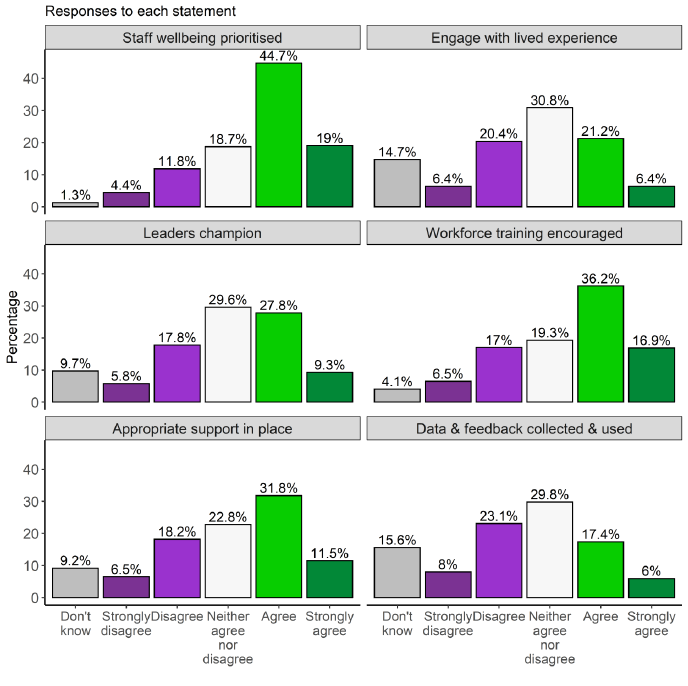
Responses by Sector, Service and Role
4.6 As with the self-assessed confidence levels described above, responses varied considerably depending on respondent characteristics. Across all six statements, there was a lower level of agreement from those who worked in the public sector when compared with both the third and private sectors. For example, while 57.2% of those working in the third sector and 47.2% of those in the private sector agreed that leaders champion trauma-informed practice and policy, just 31.4% of public sector employees agreed with this statement.
4.7 Similarly, respondents from the public sector were less likely to agree than those in the third or private sectors with the statements "data and feedback are regularly collected and used", at 17.5% compared to 41.5% and 36.1% respectively, and "people with lived experience of trauma are routinely engaged and consulted with" at 20.6% compared to 51.4% and 39.7%. It was notable that there were a high proportion of public sector respondents who replied "don't know" for both of these statements, again suggesting a lack of engagement and knowledge around how trauma-informed practice is developed and evaluated. A full breakdown of responses by sector is shown in Figure 9.
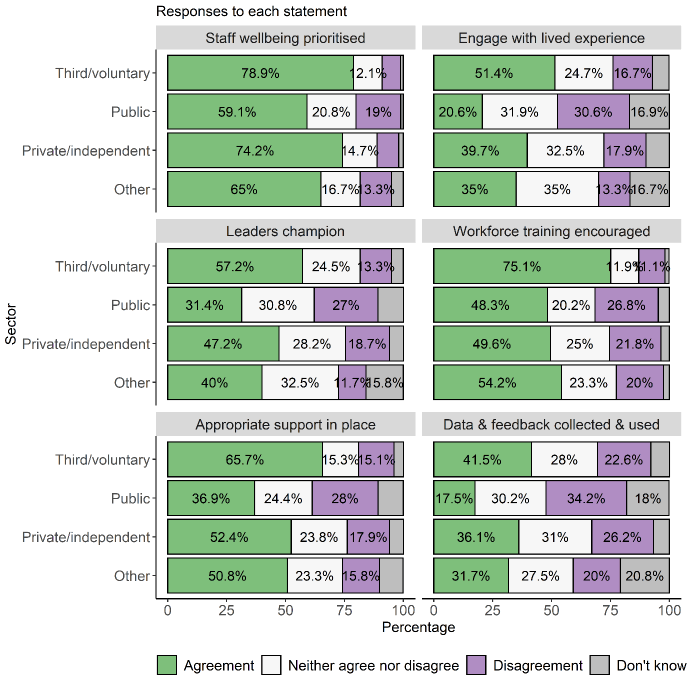
4.8 Comparison between service areas also shows significant differences in agreement with these statements. In particular, there were very high levels of agreement with each of the six statements among those who worked in alcohol and drugs and housing and homelessness. Both of these service areas appeared in the top three services areas for agreement for all statements, except "staff wellbeing is prioritised", where they featured in the top five. Across all statements, those working in these two service areas were statistically significantly more likely to agree, with the exception of "staff wellbeing is prioritised".
4.9 Those working in learning, development and training were significantly more likely to agree that staff wellbeing is prioritised. Respondents working in the mental health sector were significantly more likely to agree with the statements around appropriate support being in place for trauma-informed practice and that staff are encouraged to undertake training to develop their skills in this area. The level of agreement among service areas to each of the statements around trauma-informed organisations are shown in Figure 10, Figure 11 and Figure 12.
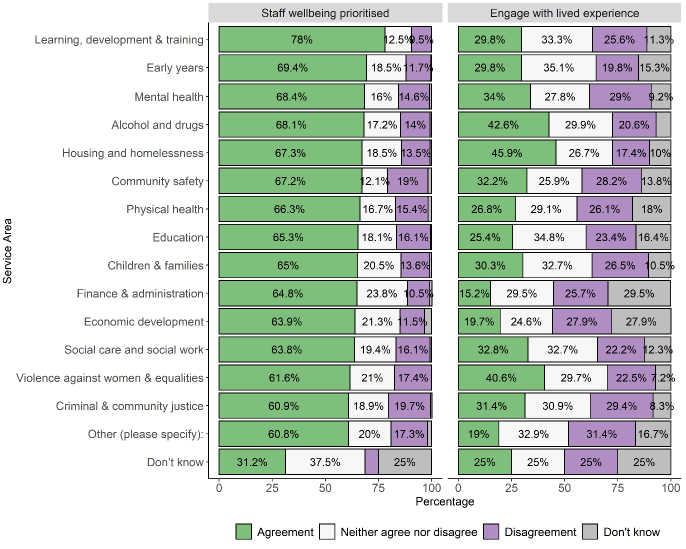
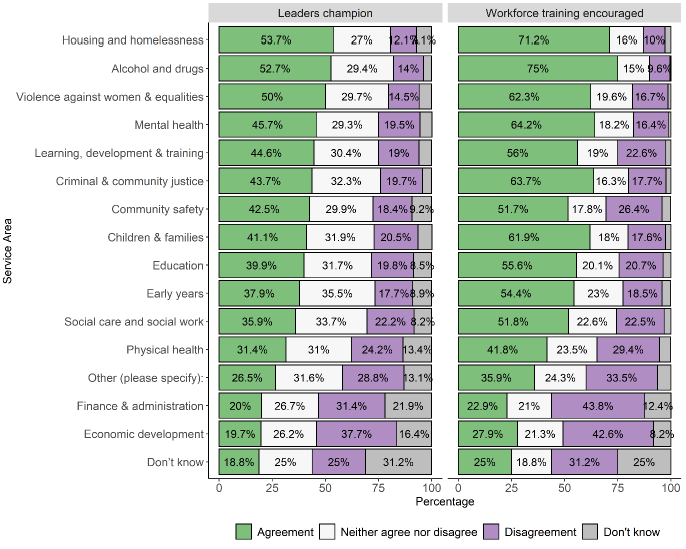
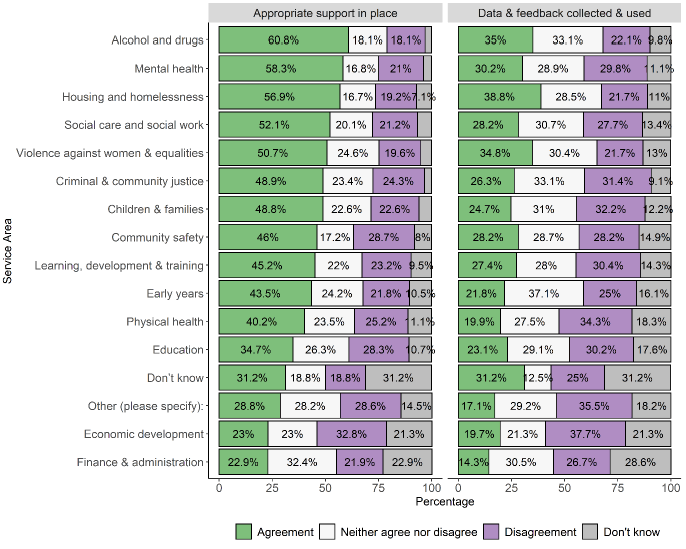
4.10 There was also some variation in agreement with these statements based on job role. Senior managers were more likely to agree with all six statements than those working in other job roles, with the exception of the statement "data and feedback are regularly collected and used", where volunteers with no line management responsibilities were the most likely to agree. Those in the category "practitioners, frontline service delivery and officers with no management responsibilities" tended to have the lowest levels of agreement with each of the statements. Figure 13, for example, shows that senior managers were almost twice as likely than practitioners to agree that those with lived experience of trauma are regularly consulted. This may suggest that while there is senior buy-in to these approaches, this is not necessarily feeding through into practice. This would correspond with some of the barriers identified below, where it was suggested that while senior leaders do encourage trauma-informed principles, sufficient time is not available to implement these in practice.
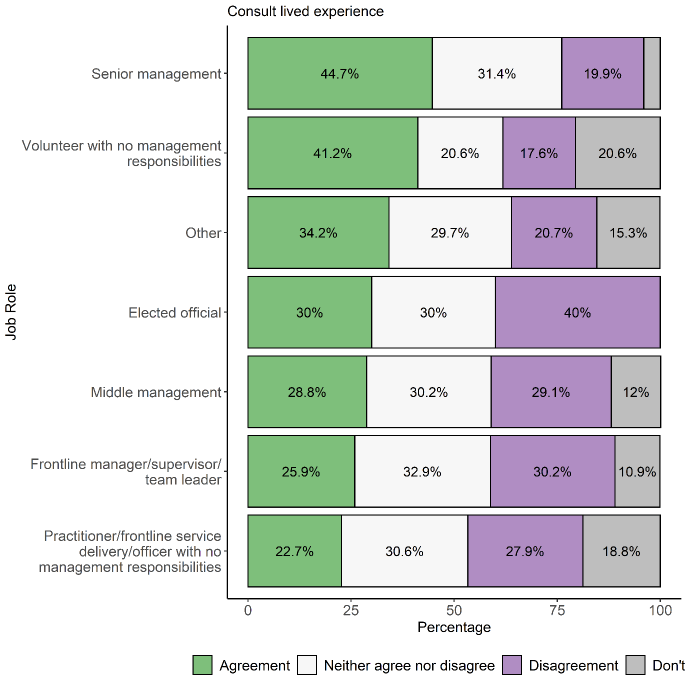
Contact
Email: ACEstrauma@gov.scot
There is a problem
Thanks for your feedback